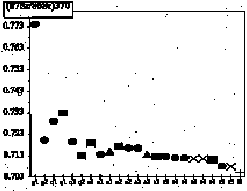
The interaction between minerals and fluids is of special interest as it can lead to mass transfer as well as it may define the generation and composition of new magmas. Metasomatic reactions related to this can perfectly be studied in fenite-aureoles around alkaline intrusive complexes, such as the Devonian (370 Ma, Kramm, 1993) Iivaara-complex in northern Finland. It is characterized by a marked contrast of isotopic signatures between the alkaline intrusive rocks ((143Nd/144Nd)370 > 0.5115; (87Sr/86Sr)370 < 0.7050) from which the fenitizing fluids were derived and Proterozoic gneisses ((143Nd/144Nd)370 < 0.5105; (87Sr/86Sr)370 > 0.7300) forming the wall rocks. The fenites have various intermediate isotopic signatures according to the degree of reaction of the fluid with the wall rocks. Consequently, the isotopic composition of the fenites allows an estimation of the metasomatic mass transfer.
The centre of the Iivaara alkaline complex is made up
by ijolites. To the peripheral part the ijolites grade without structural break into feldspar-bearing ijolites and high-grade fenites of syenitic composition which can partly reach cancrinite abundances of more than 50%. The lower-grade syenitic fenites are mainly composed of mesoperthitic alkali-feldspar and aegirine-augite. The outermost and lowest-grade quartz-bearing fenites mainly show the chemical composition of the wall rocks - but contain small amounts of aegirine-augite. Mineralogical evidence suggests that the fluid phase had a low content in H2O but was probably rich in CO2 and that the fO2 was rising to the marginal parts of the aureole. Balancing of the fluid-mineral reactions in the fenites demonstrates that Na and Fe were added by the fluid whereas SiO2 was removed.
Nd and Sr isotopic data of whole-rock samples form an array between the signatures of the ijolites in the centre and the wall rocks, showing generally increasing 87Sr/86Sr ratios and decreasing 143Nd/144Nd ratios with decreasing degrees of fenitization. However, two groups of fenites can be distinguished which are the result of differing fluid-rock exchange characteristics.
Fig. 1 shows the 87Sr/86Sr ratios (recalculated to an age of 370 Ma) of mineral fractions of samples representing the range of lithologies in the aureole. The largest spread of isotopic signatures apart from the Proterozoic wall rocks can be found in the quartz-bearing fenites whereas the spread becomes smaller with increasing degree of fenitization. The fact that different mineral phases in syenitic fenites have similar isotopic signatures though being either formed in a reaction with the fluid or exchanging matter via diffusion with the fluid indicates that the syenitic fenites have been close to isotopic equilibrium with the fluid. The general increase of the 87Sr/86Sr ratios towards lower grades of fenitization points to the gradual compositional adjustment of the fluid due to continuous reaction with the fenites on its way through the aureole.
This study offers support to the understanding of exchange properties in alkaline metasomatic systems and to the assessment of mass transfer and fluid-rock ratios.
Kramm, U. et al., Lithos 30, 33-44 (1993).
Fig. 1: 87Sr/86Sr ratios (recalculated to 370 Ma) of mineral fractions from gneisses, fenites and ijolites from the Iivaara alkaline complex. Biotites from the wall rocks have ratios larger then 2.88 and are not shown; squares = aegirine-augite, circles = feldspar, x = cancrinite, triangles = wollastonite, crosses = nepheline, g = gneiss, q = quartz-bearing fenite, s = syenitic fenite, i = ijolite.